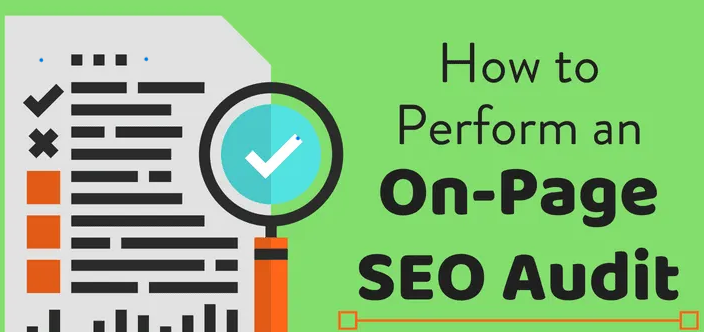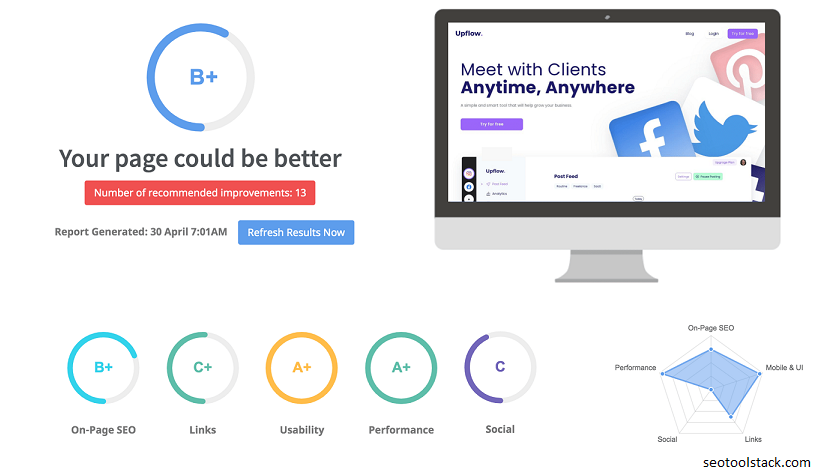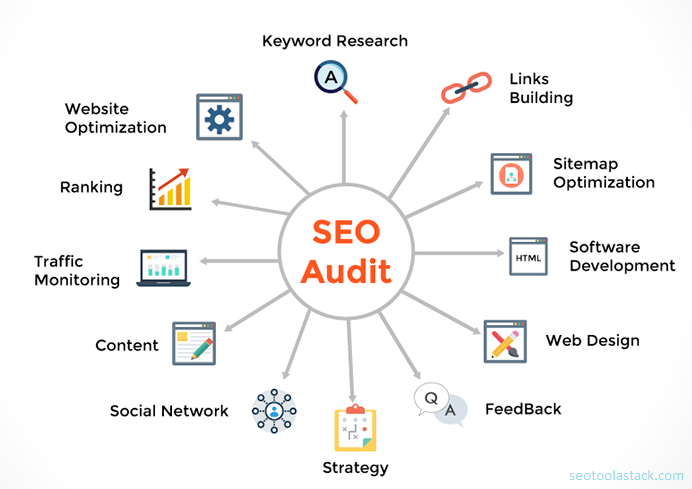

The practice of assessing how well your website is search engine optimized is called an SEO audit.
It finds mistakes that can hinder your website's search engine ranking. and identifies chances for you to become more visible.
In this manner, you can improve business outcomes, draw in more traffic, and raise your rankings.

Hard data regarding the traffic, backlink profile, and technical health of your website forms the foundation of an efficient SEO website audit. Provide comparable information on the websites of your rivals.
The two most crucial SEO auditing instruments that might assist you in doing that are:
• Semrush: An all-in-one SEO package that helps you enhance your organic search performance and offers a thorough analysis of your site's performance. For instance, Site Audit looks for more than 140 technical and on-page SEO flaws.
• Google Search Console: A collection of dashboards and reports that let you keep an eye on and troubleshoot any problems with Google's indexing of your website.
Now, let's look more closely at how to use these tools to perform an SEO audit.
Typical topics covered by SEO audits include:
• Crawlability and indexability
• Architecture of the site
• Research on keywords
• SEO on-page
• Analysis of backlinks
Visits to your website that originate from natural (unpaid) search results are referred to as organic traffic. Therefore, substantial decreases are a reliable warning that something need attention.
Use the Organic Research tool to swiftly check the amount of organic traffic to your website.
After entering your domain, select "Search."
When your results are prepared, a page called "Overview" will appear.
How many visitors your site receives each month is estimated by the "Traffic" figure at the top. Additionally, the graph displays the evolution of that figure over time.
This data can be used to identify periods of high and low traffic to your website.
The "Top Page Changes" widget makes it simple to identify the pages that have seen the largest fluctuations in traffic over the previous 28 days.
If you see an odd decline in traffic, either for a particular page or for your entire website, it could be helpful to look for manual activities that suggest Google's spam policies have been broken by your website.
If you've received a manual action, you may verify it in Google Search Console.

Under "Security & Manual Actions," select "Manual actions."
When you click it, a page with the status of your website will load.
Hopefully, a green checkmark appears, indicating that no problems have been found.
If your website is the target of a manual action, address the problems and submit a request for reconsideration.
For example, if purchasing backlinks resulted in a manual action ("Unnatural links to your site"), you will need to remove those backlinks by disavowing them or contacting webmasters to request their removal.
Pages that are absent from Google's database are said to be not indexed. Thus, Google is unable to rank them.
Use Site Audit to identify indexing problems as well as other technical SEO problems.
Search through your website and select the "Issues" option.
To view only indexing concerns, select "Indexability" from the "Category" drop-down menu.
Additionally, you can use Google Search Console to discover if your pages have been directly indexed.
Navigate to the "Pages" report located in the "Index" part of the menu on the left.
This is a graph showing every page according to its indexing status.
A list of the reasons the pages haven't been indexed is below.
Go over each of the reasons stated one by one. Examine every page that is impacted.
Recall that just the pages you wish to appear high up in search results need to be indexed. It is rather common for certain URLs to not get indexed.
Here are a few instances of URLs that are exempt from indexing requirements:
• Redirected pages
• Pages for administration
• Use canonical tags to redirect pages.
• Page feeds
If you discover a page that ought to be indexed but isn't, take Google's instructions to rectify the problem. Press the "Validate Fix" button when finished.
As an alternative, copy a specific URL and paste it into the Google Search Console dashboard's top search bar.
See the status of the URL.
By selecting the "Request Indexing" link, you may also ask Google to index the URL.
Google should only index one version of your website.
To demonstrate why, imagine that to search engines, these are all distinct copies of the same website:
• You can visit your webpage at
• www.yoursite.com
• You may access your site here.
• www.yoursite.com
Multiple URL variations for your website might lead to various problems with crawling, indexing, and ranking. so they will appear as duplicates to Google.
Moreover, PageRank can be diluted by having different versions of your website. which can potentially be detrimental to your SEO rankings.
This is easily verifiable.
Simply load your website in all of its versions into a web browser. The desired version should be immediately forwarded for you.
For instance, if you type any other version of the URL into your browser, you should be redirected to "https://yoursite.com," which is your chosen version.
If your website is available in more than one version, utilize a 301 redirect for those versions.
One of Google's primary page experience signals is mobile friendliness. Moreover, Google no longer indexes websites that are incompatible with mobile devices.
This implies that how easily mobile users can navigate your website can have a direct impact on how highly it ranks in search results.
Use the "Issues" report in Site Audit to look for issues related to mobile friendliness.
First, confirm that a mobile crawler is selected as your "user agent."
If not, select "User agent:" by clicking the gear icon located in the upper right corner of your page.
Choose "SiteAuditBot-Mobile" from the drop-down menu here. Next, select "Save."
Select the "Issues" tab.
Next, type "mobile" into the search area to view any issues your website may have with mobile devices.
Correct any mistakes, alerts, and notices that you are able to handle on your own. Then go over the remaining content with a developer.
Increased loading speed raises your Google ranking. Additionally, the user experience is improved.
Research indicates that the likelihood of users abandoning a website increases with page load time.
Go to the "Site Performance" report from your Site Audit dashboard to see how quickly your site loads.
This is were a list of all the problems affecting the loading speed of your website appears.
Click on the "Why and how to fix it" link in the row of that issue to find out more about that particular issue and how to solve it.
Take care of as many problems as you can. As a result, you ought to observe an improvement in your site's speed and ranks.
Three indicators make up Google's Core Web Vitals, which rate the overall usability of your website. Even though these indicators are mostly connected to speed, you should nevertheless include a check of them in your technical SEO audit because they have an impact on rankings.

Here's a closer look at the particular metrics:
• Largest Contentful Paint (LCP): This gauges the amount of time needed for the page's largest element to load.
• Interaction to Next Paint (INP): Indicates how quickly a website reacts to user input.
• Cumulative Layout Shift (CLS): Indicates how much the user's experience of a page shifts unexpectedly.
Site Audit includes a specific Core Web Vitals report.
Simply select "View details" from the dashboard's "Core Web Vitals" widget.
A breakdown of each measure will be shown to you; take note that INP is approximated using Total Blocking Time. similar to this
You will find a table titled "Analyzed Pages" if you scroll down.
All of the stats for every page you evaluated are shown here.
Click the "Edit list" option if you would want to alter the list of pages that are evaluated (for example, if you want to concentrate on your most crucial pages).
Change the list as you see fit. Next, select "Save."
You can use Google Search Console to verify these numbers as well.
Navigate to the "Experience" area on the left menu and select the "Core Web Vitals" report.
Reports labeled "Desktop" and "Mobile" will appear, outlining every problem along with the pages that are impacted.
For further information, select "Open Report" located at the top of each chart.
You'll get thorough insights into any Core Web Vitals problems your website might be experiencing with these reports.
The program makes a distinction between pages that require minor adjustments and those with serious problems (also known as "poor URLs").
Examine the problems and adhere to the recommendations for resolving them.
For three reasons, internal links are an essential component of SEO.
1. They facilitate website crawling by search engines.
2. They aid visitors in navigating your website.
3. They assist you in directing PageRank, sometimes referred to as "link equity" or "link juice," toward the most crucial pages.
Site Audit has a report specifically on problems with internal linking.
Within the "Internal Linking" widget, select "View details."
You will receive a list of problems with internal links. and advice on how to resolve difficulties.
A helpful summary of your pages based on Internal LinkRank (ILR), a metric that assesses the strength of your interlinking between various pages, will also be provided by the report.
By going over each category, you'll be able to distinguish between two kinds of pages:
1. Vital pages that receive insufficient internal linking (so you can send additional internal connections to them)
2. Pages with high ILR ratings, which you can utilize to share link equity with other pages.
An excellent chance to examine the keywords your rivals target is during an SEO audit. and find out what chances you might be passing up.
Launch the Keyword Gap tool, type in up to four rival domains along with your own, and select "Compare."
The keyword sets that the analyzed domains are ranking for will be compared by the tool.
Examine the "Missing" and "Weak" tabs after swiping down to the list of keywords:
• Ignoring: Search terms that your rivals rank for but you don't
• Weak: Terms for which your rivals rank higher than you
You might find some previously undiscovered hidden keyword opportunities in the list.
Compare Your Positions to Those of Your Rivals
utilizing the Keyword Gap Tool
Links pointing to your website from another website are known as backlinks.
Because Google sees backlinks as endorsements, they are crucial to SEO. particularly if those links originate from reputable sites within your industry.
In general, your site's chances of ranking well in search results increase with the number of high-quality backlinks it receives.
To locate backlink possibilities, utilize the Backlink Gap tool.
Simply insert the domains of up to four rivals together with your own. Select "Find prospects."
A list of domains that connect to your rivals but not to you will be displayed by the tool:
Given that they already connect to related websites (your competitors), these domains are probably going to link to your website as well.
Select the arrow adjacent to the figure that represents the quantity of backlinks originating from a specific domain.
By doing this, the view is expanded to include particular pages that connect to your rivals. in addition to the target URLs and anchor text.
You can now attempt to create duplicate backlinks.
Click the "Start outreach" button located in the upper-right corner after selecting the ones that pertain to your website.
The chosen leads will then be forwarded to the Link Building Tool, where you can create a new project just for your domain.
The instrument will support you in:
• Locate potential backlinks from other sources.
• Get in touch with domain owners and request backlinks from them.
• Monitor the development of your outreach initiatives.
Using a general site crawl, you can identify any technical problems with your entire website. However, it's also a good idea to examine individual pages more closely (especially your key ones).
This will assist you in evaluating their work and determining how to help them become better.
You can get aid with it from On Page SEO Checker.
Allow the program to automatically locate the keywords and pages. or manually complete them.
It's not necessary for you to review every page. Rather, pay attention to those who:
• Generate the highest number of conversions
• Concentrate on the terms that are most crucial to your company.
The tool will evaluate your data against those of your top-ranking competitors and offer helpful advice on how to raise your rankings in different on-page SEO audit categories.
To view the suggestions for a certain page, select the "Optimization Ideas" tab. Next to the URL of the page, select the "# ideas" button:
Also Read :
Keyword Strategy in SEO: How to Create New Keyword
How to Understand Your Organic CTR and Make It Better
How To Perform a Quick SEO Audit of a Website